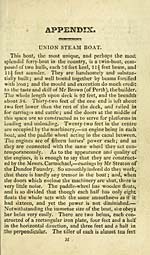Towns > Dundee > 1822 - Dundee delineated; or, A history and description of that town, its institutions, manufactures and commerce
(144)
Download files
Complete book:
Individual page:
Thumbnail gallery: Grid view | List view

1S4
long and is worked by a wheel and pinion. The
machinery is so constructed as that either end may go
foremost; and thus the boat can arrive and depart with-
out the labour or space required for turning round. —
The reversing of the motion is effected by reversing the
action of the valves of the engines. These are opened
and shut by an alternating rod, moved by an eccentric
block on the shaft of the paddle-wheel. This rod acts
upon a double lever, fastened to the rocking shaft of the
valves; when it acts on the lower end of the lever,
the paddle-wheel moves the one way, and when it acts
on the upper end, the wheel moves the other. The
lever is made broad in the middle, with a flange round
it, which retains the stud on the alternating rod during
the time that it is changed from the one end to the
other. The rod is raised or lowered by means of a
toothed sector, into which a pinion works. The two
pinions are on the opposite ends of a rod, which passes
under the index-table, below which it has a bevel wheel
acted on by a similar wheel connected with the revers-
ing index. By simply turning this index, the boat passes
in less than one minute from motion in one direction to
motion in that directly opposite. The boat may be
steered by either helm; and by working both helms at
the same time, it may be turned round in a very small
compass. Indeed, though the boat appears huge and
unwieldy, yet, in consequence of the impelling power be-
ing in the centre, it can be turned in a much smaller
compass than a less boat with two wheels. Its motion,
too, during a breeze, or across the swell, is much more
steady, as a good deal of the disagreeable rolling of a
two-wheeled boat arises from the unequal hold which its
wheels take of the water.
long and is worked by a wheel and pinion. The
machinery is so constructed as that either end may go
foremost; and thus the boat can arrive and depart with-
out the labour or space required for turning round. —
The reversing of the motion is effected by reversing the
action of the valves of the engines. These are opened
and shut by an alternating rod, moved by an eccentric
block on the shaft of the paddle-wheel. This rod acts
upon a double lever, fastened to the rocking shaft of the
valves; when it acts on the lower end of the lever,
the paddle-wheel moves the one way, and when it acts
on the upper end, the wheel moves the other. The
lever is made broad in the middle, with a flange round
it, which retains the stud on the alternating rod during
the time that it is changed from the one end to the
other. The rod is raised or lowered by means of a
toothed sector, into which a pinion works. The two
pinions are on the opposite ends of a rod, which passes
under the index-table, below which it has a bevel wheel
acted on by a similar wheel connected with the revers-
ing index. By simply turning this index, the boat passes
in less than one minute from motion in one direction to
motion in that directly opposite. The boat may be
steered by either helm; and by working both helms at
the same time, it may be turned round in a very small
compass. Indeed, though the boat appears huge and
unwieldy, yet, in consequence of the impelling power be-
ing in the centre, it can be turned in a much smaller
compass than a less boat with two wheels. Its motion,
too, during a breeze, or across the swell, is much more
steady, as a good deal of the disagreeable rolling of a
two-wheeled boat arises from the unequal hold which its
wheels take of the water.
Set display mode to: Large image | Transcription
Images and transcriptions on this page, including medium image downloads, may be used under the Creative Commons Attribution 4.0 International Licence unless otherwise stated. ![]()
| Scottish Post Office Directories > Towns > Dundee > Dundee delineated; or, A history and description of that town, its institutions, manufactures and commerce > (144) |
|---|
| Permanent URL | https://digital.nls.uk/85825759 |
|---|
| Description | Directories of individual Scottish towns and their suburbs. |
|---|
| Description | Around 700 Scottish directories published annually by the Post Office or private publishers between 1773 and 1911. Most of Scotland covered, with a focus on Edinburgh, Glasgow, Dundee and Aberdeen. Most volumes include a general directory (A-Z by surname), street directory (A-Z by street) and trade directory (A-Z by trade). |
|---|


